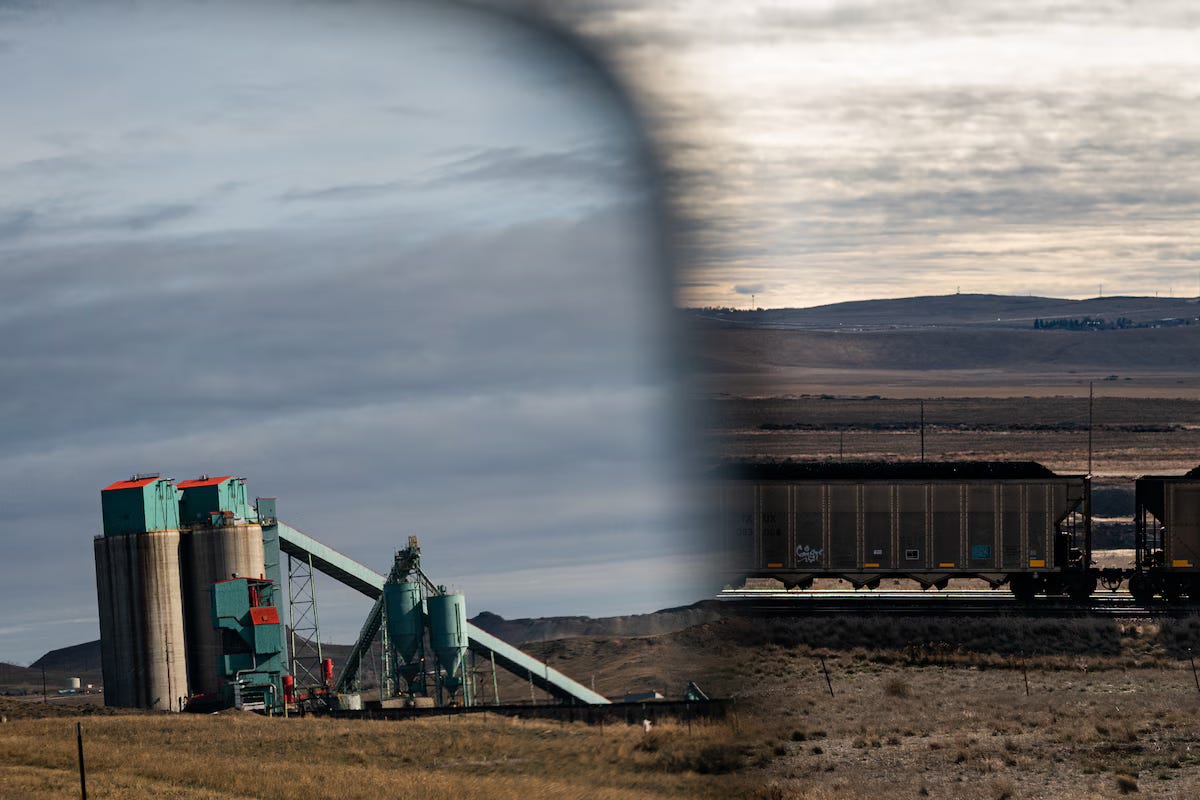The U.S. just took its biggest step yet to end coal mining Biden administration’s decision ends new leasing in Powder River Basin in Wyoming and Montana, the nation’s biggest coal-producing region
Another gigantic “Government of One” energy and hydrocarbon executive order. The size of the US federal government is now in the quadrillions. The size of its energy arrogance and ignorance is more.
The U.S. just took its biggest step yet to end coal mining
The Biden administration’s decision ends new leasing in the Powder River Basin in Wyoming and Montana, the nation’s biggest coal-producing region.
Updated May 16, 2024 at 4:36 p.m. EDT|Published May 16, 2024 at 1:57 p.m. EDT
The Eagle Butte Coal Mine, part of the Powder River Basin, in Gillette, Wyo., on Nov. 12, 2021. (Salwan Georges/The Washington Post)
Listen
6 min
Share
Comment on this story
Comment
Add to your saved stories
Add to your saved stories
Save
In one of its biggest steps yet to keep fossil fuels in the ground, the Biden administration announced Thursday that it will end new coal leasing in the Powder River Basin, which produces nearly half the coal in the United States.
Climate activists have long pushed the Interior Department to stop auctioning off leases for coal mining on public lands, and they celebrated the decision. It could prevent billions of tons of coal from being extracted from more than 13 million acres across Montana and Wyoming, with major implications for U.S. climate goals.
A significant share of the nation’s fossil fuels come from federal lands and waters. The extraction and combustion of these fuels accounted for nearly a quarter of U.S. carbon dioxide emissions between 2005 and 2014, according to a study by the U.S. Geological Survey.
"
"
In a final environmental impact statement released Thursday, Interior’s Bureau of Land Management found that continued coal leasing in the Powder River Basin would harm the climate and public health. The bureau determined that no future coal leasing should happen in the basin, and it estimated that coal mining in the Wyoming portion of the region would end by 2041.
Last year, the Powder River Basin generated 251.9 million tons of coal, accounting for nearly 44 percent of all coal produced in the United States. Under the bureau’s determination, the 14 active coal mines in the Powder River Basin can continue operating on lands they have leased, but they cannot expand onto other public lands in the region.
The decision drew praise from climate advocates who have fought for years to restore an Obama-era moratorium on coal mining on federal lands.
"
"
“This means that billions of tons of coal won’t be burned, compared to business as usual,” said Shiloh Hernandez, a senior attorney at the environmental law firm Earthjustice. “It’s good news, and it’s really the only defensible decision the BLM could have made, given the current climate crisis.”
But the move angered Republican lawmakers in Montana and Wyoming, some of whom accused Biden of waging a “war” on coal, even as the nation moves away from the fossil fuel because of market forces.
Follow Climate & environment
Follow
“President Biden continues to wage war on Wyoming’s coal communities and families,” Sen. John Barrasso (Wyo.), the top Republican on the Senate Energy and Natural Resources Committee, said in a statement. “This will kill jobs and could cost Wyoming hundreds of millions of dollars used to pay for public schools, roads, and other essential services in our communities.”
"
"
The move also infuriated mining groups, which have argued that the nation needs more — not less — fossil fuels to meet explosive energy demand fueled by electricity-hungry data centers and manufacturing facilities.
“At a time of deteriorating grid reliability, soaring electricity demand and ongoing concern about global energy shocks, proposing a plan of no new coal leasing in the Powder River Basin is outrageous,” said Rich Nolan, president and CEO of the National Mining Association. “This damages American energy security and affordability and is a severe economic blow to mining states and communities.”
The United States is moving away from coal, which has struggled to compete economically with cheaper gas and renewable energy. U.S. coal output tumbled 36 percent from 2015 to 2023, according to the Energy Information Administration. The Sierra Club’s Beyond Coal campaign estimates that 382 coal-fired power plants have closed down or proposed to retire, with 148 remaining.
"
"
In addition, the Environmental Protection Agency finalized an ambitious set of rules in April aimed at slashing air pollution, water pollution and planet-warming emissions spewing from the nation’s power plants. One of the most significant rules will push all existing coal plants by 2039 to either close or capture 90 percent of their carbon dioxide emissions at the smokestack.
“The nation’s electricity generation needs are being met increasingly by wind, solar and natural gas,” said Tom Sanzillo, director of financial analysis at the Institute for Energy Economics and Financial Analysis, an energy think tank. “The nation doesn’t need any increase in the amount of coal under lease out of the Powder River Basin.”
Sanzillo said mining companies’ interest in bidding on leases in the Powder River Basin has fallen with the coal industry’s fortunes. The decision is “a proper market response to the long-term deteriorating position of coal,” he said.
ROLEX PARTNERSHIP CONTENT
00:19
Using tradition to change how clothing is made
An entrepreneur sets a new global standard for sustainable fashion.
WATCH NOW
Much of the coal produced in the Powder River Basin is burned at power plants across the country. But small amounts are shipped overseas, with roughly 3.1 million tons exported from Wyoming in 2012 and nearly 9.1 million tons exported from Montana in 2012, accounting for around 10 percent of the coal exported from American ports that year.
Obama first froze coal leasing on federal lands in 2016, but President Donald Trump lifted that freeze two months after taking office in 2017. The move was part of Trump’s effort to fulfill his campaign promise to revive the struggling U.S. coal industry.
In 2022, a federal judge ordered the Bureau of Land Management to pause the issuing of new coal leases. In his ruling, Judge Brian Morris of the U.S. District Court for the District of Montana wrote that under the Trump administration, the bureau had failed to study the full environmental effects of permitting more mining, as required by the National Environmental Policy Act.
ROLEX PARTNERSHIP CONTENT
A “farm-to-closet” clothing brand that’s truly sustainable
Meet the entrepreneur using tradition to harmonize fashion and nature.
LEARN MORE
While Trump spoke often on the 2016 campaign trail of bringing back “beautiful, clean coal,” he has rarely mentioned coal during his 2024 campaign. Instead, the former president has repeatedly promised to reverse dozens of Biden’s policies targeting the oil and gas industry.
During a dinner at his Mar-a-Lago Club last month, Trump asked oil executives to steer $1 billion to his campaign and pledged to immediately end the Biden administration’s freeze on permits for new liquefied natural gas exports in a second term, according to people who attended. He also pledged to start auctioning off more leases for oil drilling in the Gulf of Mexico and to lift restrictions on drilling in the Alaskan Arctic.
On Wednesday, Trump attended a fundraiser in Lexington, Ky., hosted by Joseph W. Craft III, president and chief executive of coal producer Alliance Resource Partners, and his wife, Kelly Craft, the former U.S. ambassador to the United Nations.
The Trump campaign has raised more than $25 million this week, said a campaign official, who spoke on the condition of anonymity because she was not authorized to comment publicly.






